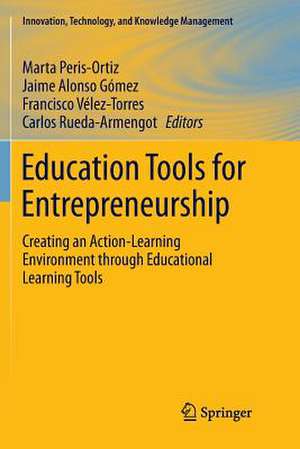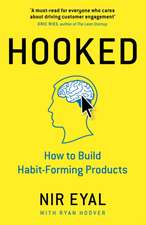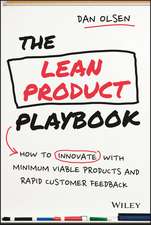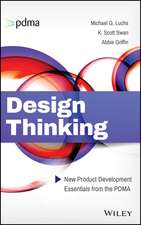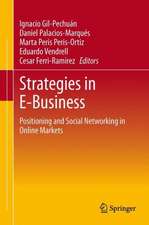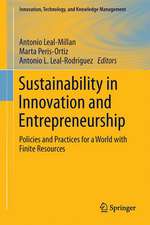Education Tools for Entrepreneurship: Creating an Action-Learning Environment through Educational Learning Tools: Innovation, Technology, and Knowledge Management
Editat de Marta Peris-Ortiz, Jaime Alonso Gómez, Francisco Vélez-Torres, Carlos Rueda-Armengoten Limba Engleză Paperback – 28 mar 2019
Entrepreneurship in society is rapidly gaining popularity as entrepreneurial activities aimed to create social value are fundamental in the development of an innovative, sustainable economy. This notion has been encouraging universities to incorporate entrepreneurship-related competencies into the curriculums of almost all subjects. Thus, developing an action-learning environment with educational innovation tools, technology tools and pedagogical methods is becoming increasingly important to universities. Students must be fully prepared to face the many challenges in the world and to help develop an innovative and sustainable economy. Universities should therefore promote active learning through innovation so that students can become active participants in their learning.
Featuring contributions and case studies from academics, researchers and practitioners from around the world, the is book provides international perspective into entrepreneurship education and innovation.
| Toate formatele și edițiile | Preț | Express |
|---|---|---|
| Paperback (1) | 638.43 lei 6-8 săpt. | |
| Springer International Publishing – 28 mar 2019 | 638.43 lei 6-8 săpt. | |
| Hardback (1) | 894.16 lei 6-8 săpt. | |
| Springer International Publishing – 22 dec 2015 | 894.16 lei 6-8 săpt. |
Din seria Innovation, Technology, and Knowledge Management
- 15%
 Preț: 643.99 lei
Preț: 643.99 lei -
 Preț: 281.97 lei
Preț: 281.97 lei - 18%
 Preț: 954.62 lei
Preț: 954.62 lei - 15%
 Preț: 653.14 lei
Preț: 653.14 lei - 18%
 Preț: 945.62 lei
Preț: 945.62 lei - 18%
 Preț: 890.54 lei
Preț: 890.54 lei - 15%
 Preț: 640.06 lei
Preț: 640.06 lei -
 Preț: 383.93 lei
Preț: 383.93 lei - 15%
 Preț: 633.02 lei
Preț: 633.02 lei - 18%
 Preț: 1124.60 lei
Preț: 1124.60 lei - 18%
 Preț: 956.81 lei
Preț: 956.81 lei -
 Preț: 389.49 lei
Preț: 389.49 lei - 15%
 Preț: 655.13 lei
Preț: 655.13 lei - 20%
 Preț: 570.97 lei
Preț: 570.97 lei - 15%
 Preț: 642.03 lei
Preț: 642.03 lei - 18%
 Preț: 941.50 lei
Preț: 941.50 lei - 15%
 Preț: 643.00 lei
Preț: 643.00 lei - 18%
 Preț: 732.52 lei
Preț: 732.52 lei - 15%
 Preț: 637.59 lei
Preț: 637.59 lei - 18%
 Preț: 890.06 lei
Preț: 890.06 lei - 15%
 Preț: 635.47 lei
Preț: 635.47 lei - 15%
 Preț: 638.57 lei
Preț: 638.57 lei -
 Preț: 391.99 lei
Preț: 391.99 lei -
 Preț: 391.99 lei
Preț: 391.99 lei - 15%
 Preț: 632.22 lei
Preț: 632.22 lei - 20%
 Preț: 584.72 lei
Preț: 584.72 lei - 15%
 Preț: 642.18 lei
Preț: 642.18 lei - 18%
 Preț: 894.16 lei
Preț: 894.16 lei - 18%
 Preț: 943.73 lei
Preț: 943.73 lei - 15%
 Preț: 644.49 lei
Preț: 644.49 lei - 18%
 Preț: 947.85 lei
Preț: 947.85 lei - 15%
 Preț: 656.89 lei
Preț: 656.89 lei - 18%
 Preț: 954.45 lei
Preț: 954.45 lei - 18%
 Preț: 1006.72 lei
Preț: 1006.72 lei - 18%
 Preț: 727.31 lei
Preț: 727.31 lei - 15%
 Preț: 642.51 lei
Preț: 642.51 lei - 18%
 Preț: 953.65 lei
Preț: 953.65 lei - 15%
 Preț: 639.59 lei
Preț: 639.59 lei - 15%
 Preț: 645.47 lei
Preț: 645.47 lei - 18%
 Preț: 952.26 lei
Preț: 952.26 lei - 15%
 Preț: 639.08 lei
Preț: 639.08 lei
Preț: 638.43 lei
Preț vechi: 751.10 lei
-15% Nou
Puncte Express: 958
Preț estimativ în valută:
122.18€ • 126.83$ • 101.88£
122.18€ • 126.83$ • 101.88£
Carte tipărită la comandă
Livrare economică 24 martie-07 aprilie
Preluare comenzi: 021 569.72.76
Specificații
ISBN-13: 9783319796536
ISBN-10: 3319796534
Pagini: 247
Ilustrații: VIII, 247 p. 52 illus., 21 illus. in color.
Dimensiuni: 155 x 235 mm
Greutate: 0.36 kg
Ediția:Softcover reprint of the original 1st ed. 2016
Editura: Springer International Publishing
Colecția Springer
Seria Innovation, Technology, and Knowledge Management
Locul publicării:Cham, Switzerland
ISBN-10: 3319796534
Pagini: 247
Ilustrații: VIII, 247 p. 52 illus., 21 illus. in color.
Dimensiuni: 155 x 235 mm
Greutate: 0.36 kg
Ediția:Softcover reprint of the original 1st ed. 2016
Editura: Springer International Publishing
Colecția Springer
Seria Innovation, Technology, and Knowledge Management
Locul publicării:Cham, Switzerland
Cuprins
Chapter 1 Classroom Experiments: A Useful Tool for Learning about Economic and Entrepreneurial Decisions.- Chapter 2 An experience in teaching innovation based on collaborative learning and the Aronson jigsaw technique.- Chapter 3 Learning by teaching and assessing: A teaching experience.- Chapter 4 DINNO® — An Innovative Technological Tool for Empowerment in Assessment.- Chapter 5 Towards sustainable assessment: ICT as a facilitator of self- and peer assessment.- Chapter 6 Entrepreneurship Education: a Tool for Development of Technological Innovation.- Chapter 7.- Teaching entrepreneurship: A comparison between virtual and classroom teaching contexts.- Chapter 8 Enhancement of entrepreneurship in Colombian universities: Competence Approach Plus Personalized Advice (CAPPA) model.- Chapter 9 Game driven education in finance through on-line trading tools.- Chapter 10 Educating for Entrepreneurship: Application to the Business Services Marketing Subject.- Chapter 11 Work andstudy habits in the interconnected age: What it means for businesses of the future.- Chapter 12 Experiential activities: A tool to increase entrepreneurial skills.- Chapter 13 Fostering entrepreneurship in higher education, by problem-based learning.- Chapter 14 Best University Practices and Tools in Entrepreneurship.- Chapter 15 Innovation in Entrepreneurship Education: Developing Competitive Advantages for MBA Students.- Chapter 16 Resources and To
ols of the Firm: Competencies and Entrepreneurship.- Chapter 17 Entrepreneurship in higher education as a horizontal competence.
ols of the Firm: Competencies and Entrepreneurship.- Chapter 17 Entrepreneurship in higher education as a horizontal competence.
Recenzii
“The book represents a teaching and assessment tool for innovation and entrepreneurship education, and exploratory experiments and practice were used to confirm the effectiveness of these tools. … the book presents operational entrepreneurship classroom teaching methods and assessment methods, such as the ‘Classroom Experiments’ tool, which will provide significant guidance for entrepreneurship classroom teaching in all countries. Operational and practical is the striking feature of this book.” (Yinghua Ye and Rui Hu, Higher Education, Vol. 74, 2017)
Textul de pe ultima copertă
This book examines education in entrepreneurship through an action-learning environment that employs various education tools, technology tools and pedagogical methods being implemented into university curriculums around the world.
Entrepreneurship in all of its aspects, connotations, and applications has undoubtedly become a major force for new and sustainable wealth creation in both emerging and developed economies. This notion has been encouraging universities to incorporate entrepreneurship-related competencies into the curriculums of almost all subjects, as researchers, educators, and administrators alike acknowledge that students must be fully engaged and prepared to thrive in a society increasingly defined by innovation.
In this context, the primary challenge consists in how to inspire or work beyond the mental limits in the classroom; to determine which learning platforms are required or useful to unlock and stimulate creativity and eliminate the human aversion tofailure.
Featuring contributions and case studies academics and practitioners across a wide spectrum of learning environments, the authors address such fundamental questions as:
Entrepreneurship in all of its aspects, connotations, and applications has undoubtedly become a major force for new and sustainable wealth creation in both emerging and developed economies. This notion has been encouraging universities to incorporate entrepreneurship-related competencies into the curriculums of almost all subjects, as researchers, educators, and administrators alike acknowledge that students must be fully engaged and prepared to thrive in a society increasingly defined by innovation.
In this context, the primary challenge consists in how to inspire or work beyond the mental limits in the classroom; to determine which learning platforms are required or useful to unlock and stimulate creativity and eliminate the human aversion tofailure.
Featuring contributions and case studies academics and practitioners across a wide spectrum of learning environments, the authors address such fundamental questions as:
- Can educators teach entrepreneurship?
- Can universities teach that failure may be a necessary part of this process?
- Is the education or the conditions created in the surrounding environment the key factor?
- Is there an entrepreneurial education tool or methodology that could help students to develop an entrepreneurial attitude or mind-set?
Caracteristici
Examines education in entrepreneurship through an action-learning environment that uses educational innovation tools Explores various education tools, technology tools and pedagogical methods being implemented into university curriculums around the world Features a variety of contributions and case examples from different countries Includes supplementary material: sn.pub/extras
